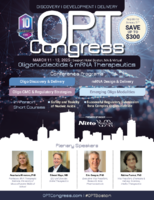2025年 プレナリー講演者

Anastasia Khvorova, PhD
Professor, RNA Therapeutic Institute, University of Massachusetts Medical School

Eric Swayze, PhD
Executive Vice President, Research, Ionis Pharmaceuticals

Edward Kaye, MD
CEO and Director, Stoke Therapeutics

Rubina Parmar, PhD
Vice President, Chemistry & Delivery Sciences, Intellia Therapeutics






























